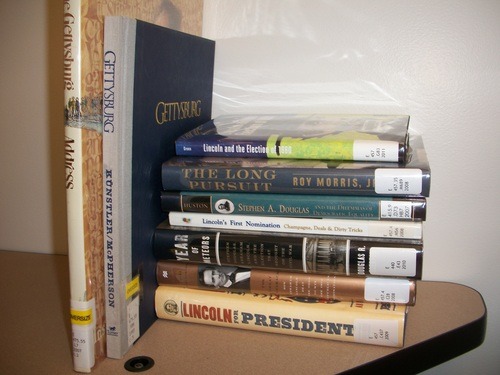I can’t help but wonder what my AP U.S. History teacher, Robert C. Lemire, Jr., would say if he knew I was designing an exhibit on the Election of 1860. I get chills every time I crack open a book from the research stack on my desk; suddenly I can hear his college-style lectures all over again, drilling me about the differences between popular sovereignty and free soil. Who knew that after two years of being out of high school, the old curriculum would find its way back to me? I’ll have to shoot Mr. Lemire an email.

^My secret stash of books for research.
Although I wasn’t initially too excited about having to research Lincoln, Douglas, Fremont, and the like again, I’m actually finding myself more intrigued as I move forward on my project. What interests me most, though, are the artifacts and documents I’m beginning to gather from Special Collections. It’s helping my research so much more to have an idea of what I’ll be displaying. To give you an idea of some of the items I’m considering, here’s a rough list:
- Political cartoons (3) (“The Original Squatter Sovereign,” “Shaky,” “Keeping Queer Company”; All of these are from 1860 issues of Vanity Fair)
- Pamphlets - Addresses/Speeches (2-3) (“Abraham Lincoln, His Personal History and Public Record,” “How Ought Workingmen to Vote in the Coming Election,” etc.)
- Letter (1) - Written by George W. Beidelman, 10/18/1860 - Comments specifically on the election!
- Assorted artifacts/memorabilia:
- Replica of Lincoln campaign badge (1)
- Campaign ribbons (3)
- Bottle caps (“Lincoln Root Beer,” “Lincoln Orange Soda”) (2) **These were my personal favorite.**
- Buttons (2)
- Small oval portrait (1)
- Figurine, small busts, etc.
My work with these objects strongly reminds me of my “Art and Public Policy” class from last fall. The course culminated in a Schmucker Art Gallery exhibit called “Art + Politics,” which called us to research nonconventional art objects and place them in the context of culture, public policy, and politics. Likewise, the political cartoons I found from 1860 especially demonstrate how art can be a mechanism to influence public opinion, and at the same time serve as an indicator of sociopolitical trends. These cartoons, published in popular magazines such as Harper’s Weekly and Vanity Fair, were surely propaganda tools used to both amuse and coerce the public. It's so interesting.
It was brought up in an Exhibits email recently that the library needed something to replace the Election exhibit in the spring semester. Since I noticed that our Civil War Era Digital Collections has an extensive collection of political cartoons, I suggested to Meggan that the replacement exhibit focus on these political drawings and comics. What better way to transition from a Civil War Election exhibit than to feature another politically oriented display? She seemed to like the idea- I hope I get to work on planning this one, too!
No comments:
Post a Comment